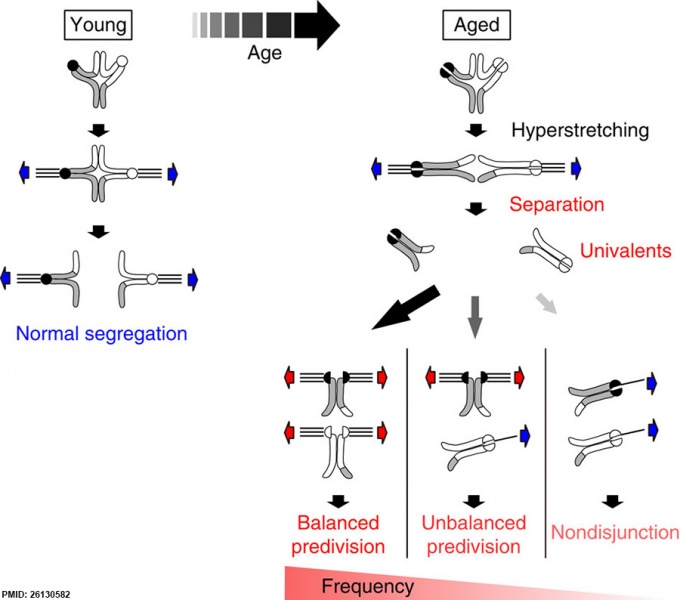File:Age-related chromosome segregation errors during MI model.jpg

Original file (900 × 794 pixels, file size: 112 KB, MIME type: image/jpeg)
Premature bivalent separation into univalents precedes age-related chromosome segregation errors during MI.
Bivalents with weakened cohesion in aged oocytes undergo hyperstretching and separation into univalents by microtubule-mediated bipolar spindle forces. This bipolar forces in turn biorient the sister KTs of the univalents. The univalents are therefore strongly biased towards predivision of sister chromatids, including balanced predivision. After balanced predivision during MI, the chromatids undergo random segregation during MII.
Reference
PMID 26130582
Copyright
This work is licensed under a Creative Commons Attribution 4.0 International License. The images or other third party material in this article are included in the article’s Creative Commons license, unless indicated otherwise in the credit line; if the material is not included under the Creative Commons license, users will need to obtain permission from the license holder to reproduce the material. To view a copy of this license, visit http://creativecommons.org/licenses/by/4.0/
Nat Commun. 2015 Jul 1;6:7550. doi: 10.1038/ncomms8550. Bivalent separation into univalents precedes age-related meiosis I errors in oocytes. Sakakibara Y1, Hashimoto S2, Nakaoka Y2, Kouznetsova A3, Höög C3, Kitajima TS1. Author information Abstract The frequency of chromosome segregation errors during meiosis I (MI) in oocytes increases with age. The two-hit model suggests that errors are caused by the combination of a first hit that creates susceptible crossover configurations and a second hit comprising an age-related reduction in chromosome cohesion. This model predicts an age-related increase in univalents, but direct evidence of this phenomenon as a major cause of segregation errors has been lacking. Here, we provide the first live analysis of single chromosomes undergoing segregation errors during MI in the oocytes of naturally aged mice. Chromosome tracking reveals that 80% of the errors are preceded by bivalent separation into univalents. The set of the univalents is biased towards balanced and unbalanced predivision of sister chromatids during MI. Moreover, we find univalents predisposed to predivision in human oocytes. This study defines premature bivalent separation into univalents as the primary defect responsible for age-related aneuploidy. PMID: 26130582
Figure 5:
File history
Click on a date/time to view the file as it appeared at that time.
| Date/Time | Thumbnail | Dimensions | User | Comment | |
|---|---|---|---|---|---|
| current | 11:11, 4 July 2015 |  | 900 × 794 (112 KB) | Z8600021 (talk | contribs) | Premature bivalent separation into univalents precedes age-related chromosome segregation errors during MI. Bivalents with weakened cohesion in aged oocytes undergo hyperstretching and separation into univalents by microtubule-mediated bipolar spindl... |
You cannot overwrite this file.
File usage
The following 3 pages use this file: